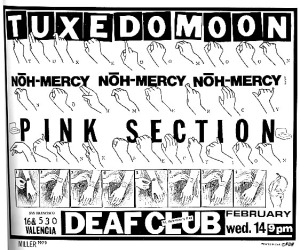Visual Vitriol and the Center for Punk Arts has begun a large punk history project exploring the intersections between Deaf and Punk culture, which is dedicated to participants like Olin Fortney (who is currently very ill), former member of the San Francisco Club for the Deaf, longtime punk enthusiast, and ASL teacher, and Sabina England, Deaf Muslim punk filmmaker, writer, and cultural critic. We highly encourage your help and input. Although the research is academic -oriented, we will make efforts to also compile an article for popular press magazines as well. Already, icons from the Dils, DOA, and Negative Trend have been providing us with insight and memories. We hope to reach out to you as well. So, if you have any relevant information, documentation, or materials, please contact us without delay at leftofthedialmag@hotmail.com. See our abstract below:
Abandoning the City of the Ear: The Interplay and Interpenetration of Punk and Deaf Identities
For decades, describing the voice of iconic Blank Generation performers has constituted the normalized narrative of punk rock critiques. The supposed raw power and authenticity of the genre are often directly linked to such orality: Joe Strummer’s “barbaric-yawp” shapes perceptions of his inflammatory streetwise ideology (songs like “London’s Burning”); Johnny Rotten’s persona is subsumed by the filth, ugliness, and vitriol of his “ruthless-growl” (“Bodies”); while Poly Styrene’s bristling howl, which could disinfect a toilet according to writer Greil Marcus, becomes a codex for living in the age of commodity-hypnotized consumer culture (“Warrior in Woolworths” and “The Day the World Turned Dayglo”). Karina Eileraas even argues punk women used such “impure” voices for “cathartic expression” to articulate their sense of self and “revolt against grammar and syntax of phallogocentrism” (1997). This emphasis on ‘think-oral,’ however, may eclipse other legacies of punk, including how the genre fostered liminal social spaces, translocal community-building, performative rituals such as distressing dances and rough-hewn dress, and the effective conceits and inventiveness of punk texts, which deaf punk participants can fully experience and appreciate. Since deaf punks have largely gone unnoticed, perhaps even suffered marginalization, in both academic and popular press tomes invoking punk culture, I will argue they represent an unheard, invisible minority testing punk’s sense of multivocality and mixophilic diversity. Combining hints of Stuart Hall’s notion of “multicultural drift,” Paul Hodkinson’s analysis and axioms of subculture status (identity, commitment, consistent distinctiveness, and autonomy), and folklore-based ethnography, I will: explore a short history of deaf/punk intersections, such as San Francisco’s infamous Deaf Club, which featured the Mutants and Dead Kennedys in the late 1970s; document the ways deaf punks navigate and make meaning from punk; and probe whether they represent a subaltern group within the community.


